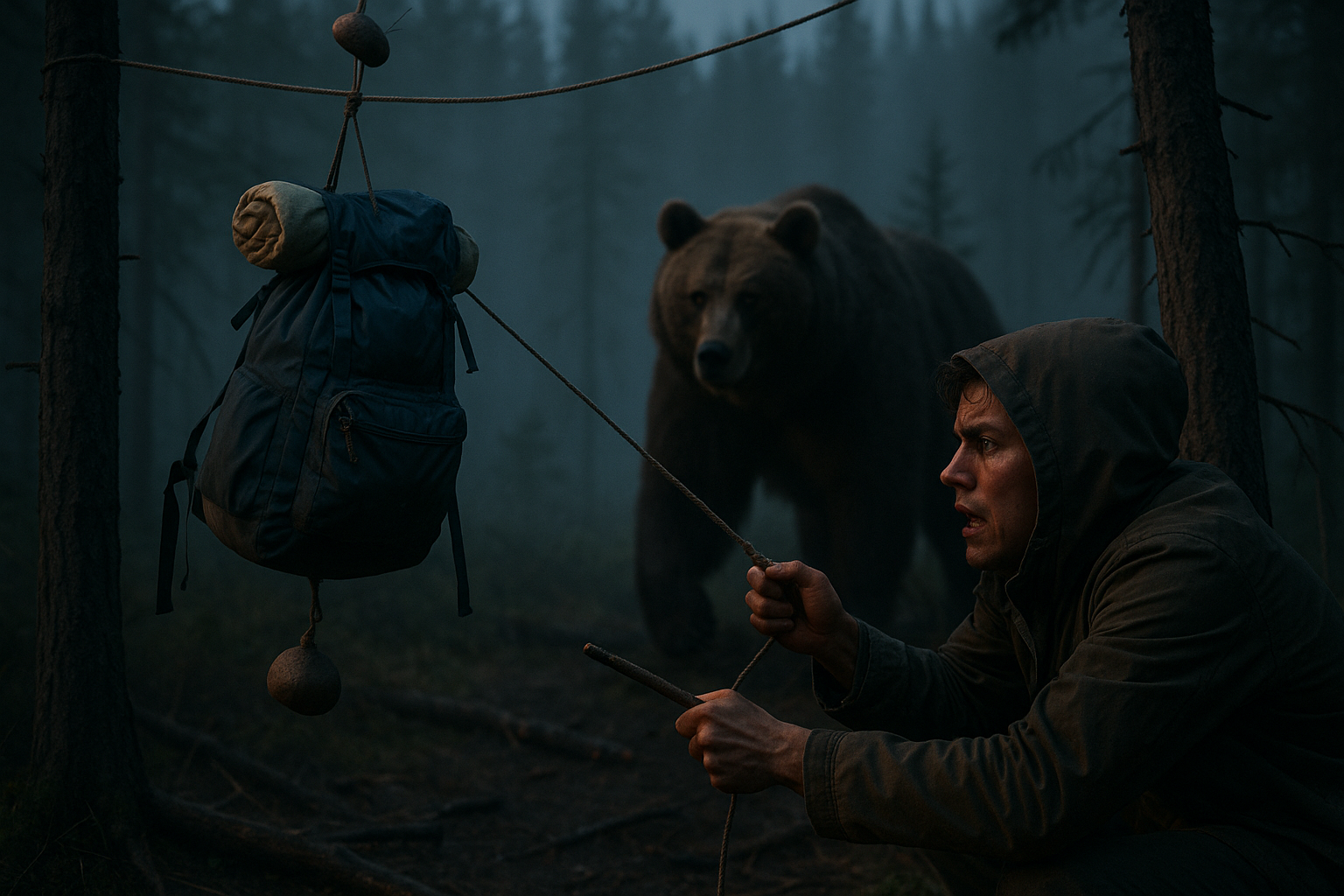It’s late at night, and you’re huddled inside your tent. You hear the crackle of leaves, the snap of twigs—then a low growl in the distance. You know what’s out there. You can smell it too—because your campfire meal scraps, your snacks, and even your toothpaste are calling out to every curious creature in the woods. This is survival camping at its grittiest. When bears, raccoons, or worse start circling your camp, it’s too late to wish you’d planned better. You need to act—fast and smart.
Here’s the thing: Not every campsite offers those perfect tree branches to hang a bear bag. What if you’re camping in scrubland, desert, or even windswept mountains where trees are sparse or too fragile? And you left your fancy bear canister at home because, well, you thought you’d be fine.
This post is for you—the camper whose life depends on outsmarting the wildlife, using nothing more than clothesline, sticks, branches, and a bit of field ingenuity.
Why Hanging Food Is Your First Line of Defense
Leaving your food at ground level is like serving an open buffet to every creature within sniffing distance. Not only can it attract dangerous wildlife like bears and mountain lions, but even small intruders like rodents can chew through your gear, contaminating your supplies and increasing the risk of disease.
A suspended food hang does two things:
✅ It creates a physical barrier between your supplies and the ground-bound or climbing wildlife.
✅ It isolates scents, especially if you wrap your food in odor-proof bags, making it less likely to attract predators.
But a standard tree-hung bag isn’t always possible. So what’s a smart survivalist to do?
The Clever Clothesline-and-Stick Hang: A Field-Tested Lifesaver
This ingenious hack combines common gear—like a simple clothesline or paracord—with field elements such as sticks, branches, and strategically balanced stones to create a suspended food hang that works even when you’re surrounded by low vegetation or no trees at all.
Here’s how to MacGyver your way out of danger:
🪢 Step 1: Find Two Upright Supports (or Improvise Them)
If you’re lucky, you might find two sturdy branches, boulders, or even a rocky outcrop to anchor your line. If not, use your trekking poles, paddles, or even a broken-down bike frame as makeshift supports.
- Drive the sticks or supports into the ground, spacing them about 10–15 feet apart for stability.
- Reinforce them with balanced stones at the base to prevent tipping under tension.
🪢 Step 2: Set Up a Highline Clothesline
- Tie your clothesline (or paracord) between the two supports, creating a high, taut line.
- Ensure it’s elevated at least 10 feet off the ground (higher if possible) to keep it out of reach of most wildlife.
- Use a truckers’ hitch or similar tensioning knot to pull it tight.
If you don’t have two supports:
- Find a single, tall anchor (like a boulder or a scrub tree) and use a balanced stone or a weighted bag at the other end to act as a counterbalance.
🪢 Step 3: Create a Suspended Hang Point with a Stick
- Take a long, sturdy stick or branch (3–5 feet long) and tie a short length of clothesline to its center.
- Hang the stick over the taut highline, so it balances like a seesaw.
- Attach your food bag to one end of the stick, and tie a counterweight (like a balanced stone or a filled dry bag) to the other end.
- The counterweight pulls the food bag higher, while the stick prevents animals from simply climbing down the line.
🪢 Step 4: Seal Your Food Properly
- Double-bag your food in odor-proof bags or use dry bags if you’re near water.
- Include all scented items—toothpaste, soap, even wrappers.
🪢 Step 5: Use Balanced Stones for Stability
- Place balanced stones or heavy gear at the base of your supports to stop them from shifting in high winds or if an animal tugs the line.
- This stealthy method avoids hammering in stakes (which can damage delicate environments) and keeps your setup low-profile.
Field Tips: When Every Second Counts
- No trees at all? Create a tripod from three sturdy sticks, lash them together with paracord at the top, and suspend your clothesline from it.
- Facing high winds? Tie your setup down with additional lines and balanced stones to prevent swaying.
- Short on rope? Use shoelaces, inner tent lines, or even your belt to extend your reach.
Why This Method Works in Real Emergencies
This isn’t a gimmick—it’s a real, field-tested survival hack for situations where you’re:
- Stranded in tree-sparse terrain like deserts, beaches, or rocky outcrops.
- Caught in a storm or floodplain, where standard hanging options are gone.
- Out of gear but surrounded by natural elements you can MacGyver into use.
It works because it leverages balance, tension, and gravity, forcing animals to work against unstable counterweights and sharp angles they can’t navigate.
A Quick Comparison: Why Not Just a Bear Canister or Tree Hang?
| Method | Pros | Cons |
|---|---|---|
| Bear Canister | Legal in some parks, secure | Heavy, bulky, expensive |
| Tree Hang | Classic, effective in wooded areas | Requires proper trees, skill to rig |
| Clothesline-and-Stick Hang | Ingenious, works anywhere with branches and rocks | Requires improvisation, setup effort |
Personal Anecdote: The Night the Coyotes Came
I’ll never forget that trip along a remote desert washout, where trees were sparse and the coyotes circled just outside the firelight. I didn’t have a bear canister, and the low shrubs were useless. With nothing but a clothesline, my trekking poles, and a few rocks, I rigged up a makeshift hang that got my food 12 feet off the ground. I heard them pacing around, but they gave up and left. I woke up at dawn, alive and well-fed.
Don’t Wait for Disaster to Strike
When you’re deep in the wilderness and wildlife is closing in, you can’t afford to fumble. Mastering the clothesline-and-stick hang isn’t just about clever survival—it’s about keeping yourself alive when all the usual options fail.
If you’re packing for your next survival camping trip, consider adding:
✅ A Sea to Summit Lite Line Clothesline (compact and versatile) [Available on Amazon]
✅ Paracord 550 (ultralight and reliable) [Available on Amazon]
✅ Odor-proof food bags (essential for scent control) [Available on Amazon]
Conclusion: Ingenuity Is Your Greatest Survival Tool
When the howls echo through the trees and your firelight dims, you’ll be glad you mastered this clever survival hang. It’s more than a camping trick—it’s a lifeline. Next time you’re out there, don’t just hope for safety. Hang your food smart, stay alive, and leave no trace.

